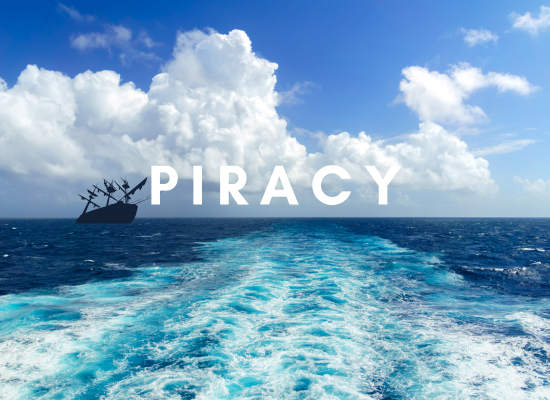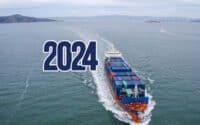High Seas, High Costs: The Economic Impact of Modern Piracy on Global Shipping

Piracy doesn’t just threaten ships; it threatens entire supply chains and the global economy. Let’s dive into why the shipping routes affected by piracy are so crucial and what moves through these maritime highways.
* Please send feedback/suggestions to editor @ shipuniverse.com
Importance of Affected Routes in Terms of Global Commerce
The world relies heavily on a few key maritime routes for the bulk of its international trade. These include the Suez Canal, connecting Europe and Asia without the need to navigate around Africa; the Strait of Malacca, a critical chokepoint between the Pacific and Indian Oceans near Singapore; and the Panama Canal, which links the Atlantic and Pacific Oceans, saving ships from the long voyage around South America. Each of these routes is vital for efficient global commerce, acting as the main arteries of international trade. When piracy threatens these routes, it directly impacts the flow of trade and, consequently, global markets.
Volume of Trade Passing Through These Routes
These key shipping lanes see immense volumes of trade each year. For instance:
- Suez Canal: Over 30% of the world’s shipping container volume passes through this canal, including approximately 12% of total global trade of goods.
- Strait of Malacca: It is one of the busiest straits worldwide, with about a quarter of all oil carried by sea passing through here, alongside thousands of ships each year.
- Panama Canal: While smaller in volume compared to the others, it still sees the transit of over 13,000 ships per year, carrying more than 300 million tons of goods.
Types of Goods Typically Transported
The types of goods that flow through these critical waterways are as diverse as they are essential:
- Suez Canal: Primarily oil, liquefied natural gas (LNG), grains, and other commodities.
- Strait of Malacca: Largely oil, electronics, and manufactured goods. This route is particularly crucial for Asian manufacturing and energy supplies.
- Panama Canal: Soybeans, coal, and manufactured goods are predominant, reflecting the broad economic interests tied to North and South American commerce.
Direct Costs of Piracy
Piracy poses a significant threat to maritime operations, leading to direct financial burdens for the shipping industry. These costs are primarily in two areas: insurance premiums and security measures. Here’s how these costs break down:
Increased Insurance Premiums for Vessels Traveling Through High-Risk Areas
Insurance is a major cost factor for ships passing through piracy-prone waters. Due to the increased risk, insurance companies often charge higher premiums for vessels operating in these areas. This type of insurance, known as “war risk” insurance, can spike significantly when a route passes through a known hotspot of pirate activity, such as the Gulf of Aden or the Gulf of Guinea. For example, following a surge in pirate attacks, insurance costs can increase by tens of thousands of dollars per voyage. This spike in insurance not only affects the operating costs of each ship but also contributes to higher costs for goods transported through these routes.
Costs Related to Security Measures on Ships
In response to the threat of piracy, shipping companies have invested heavily in security measures to protect their vessels, cargo, and crew. These measures include:
- Hiring Armed Guards: One of the most effective defenses against pirates is the presence of armed security personnel aboard ships. While this significantly reduces the risk of successful pirate attacks, it also represents a substantial financial investment. The cost of maintaining armed guards can be considerable, especially given the need for them throughout the risk-prone areas of a journey.
- Security Upgrades and Equipment: Beyond personnel, ships often need specialized security upgrades. These can include reinforced secure rooms (often called citadels) where crew members can hide during a pirate attack, as well as surveillance and monitoring systems, enhanced communication devices, and physical barriers like water cannons and razor wire. The initial installation and ongoing maintenance of these systems add to the financial strain on shipping companies.
Indirect Costs of Piracy
While the direct costs of combating piracy are substantial, the indirect costs can be even more pervasive and damaging to the shipping industry. These costs come from the need to adapt operations in ways that are less efficient but necessary for safety. Here’s a deeper look at these indirect costs:
Rerouting of Ships to Avoid High-Risk Areas
To minimize the risk of pirate attacks, shipping companies often reroute their vessels to avoid known piracy hotspots. While this might reduce the likelihood of encountering pirates, it comes with its own set of costs:
- Additional Fuel: Longer routes mean more fuel consumption. This not only increases expenses but also has environmental implications due to higher emissions.
- Longer Transit Times: Deviating from the most direct paths results in longer journey times. This can delay the delivery of goods, which is particularly problematic for perishable items or for industries that rely on just-in-time manufacturing processes.
- Increased Labor Costs: Extended voyages require more days of work from the crew, leading to higher wages and potentially more crew members to meet maritime labor laws regarding work hours and rest periods.
These rerouting measures, while essential for safety, inflate the operational costs and can decrease the overall efficiency of shipping operations.
Loss of Business and Market Delays
Piracy also introduces unpredictability into shipping schedules, which can ripple out into broader economic consequences:
- Market Delays: Delays in delivery can disrupt the supply chain, affecting everything from production schedules to retail sales. This unpredictability can make it difficult for companies to plan their inventory and production, leading to lost sales and diminished service quality.
- Loss of Business: Consistent delays or the perceived risk of shipping in certain areas can lead companies to seek alternative routes or even different transportation methods, such as air freight, despite its higher costs. Over time, this can lead to a loss of business for shipping companies that operate in or near high-risk areas.
- Impact on Contracts and Negotiations: The unpredictability caused by piracy can complicate contract negotiations with customers who require reliable delivery schedules. This may force shipping companies to lower their rates or offer more flexible terms, which can affect their bottom line.
Impact on Ship Management and Operational Strategies
Piracy not only influences the global economic landscape but also profoundly affects the day-to-day operations and strategic planning within the shipping industry. Companies must adapt their management practices and operational strategies to mitigate the risks associated with piracy. Here’s how these adaptations play out:
Changes in Ship Management Practices Due to Piracy Threats
In response to the constant threat of piracy, ship management practices have evolved significantly. Two key adjustments are commonly observed:
- Speed Increases: In pirate-prone waters, one of the simplest yet fuel-intensive tactics is increasing a ship’s speed. Pirates typically use smaller, less powerful boats, making it difficult for them to catch up to or board a fast-moving ship. However, running at higher speeds results in significantly higher fuel consumption, which not only increases costs but also impacts the environmental footprint of the voyage.
- Convoy Systems: Another strategic approach is the use of convoy systems, especially in highly dangerous areas. Ships travel in groups with naval escorts, coordinated by international naval forces or through private arrangements. While convoys can effectively reduce the risk of pirate attacks, organizing and participating in these requires detailed planning and coordination, potentially leading to delays and increased logistical complexity.
Decision-Making Processes for Route Planning and Risk Assessment
The threat of piracy also impacts the more strategic aspects of shipping operations, particularly in route planning and risk assessment:
- Advanced Route Planning: Shipping companies invest in sophisticated software and hire specialists to analyze routes based on the latest piracy reports and political stability of regions. This planning is crucial for avoiding high-risk areas and determining the safest and most cost-effective route for each voyage.
- Dynamic Risk Assessment: The situation in pirate-infested waters can change rapidly. Companies must continually assess the risk levels based on the latest intelligence and piracy trends. This ongoing risk assessment informs decisions not just about routes but also about the level of security needed, which can vary from one voyage to the next.
- Compliance and Liaison with International Bodies: Shipping firms must also navigate complex international regulations and cooperate with bodies like the International Maritime Organization (IMO) and regional maritime authorities. Compliance with their guidelines and participation in reporting and monitoring systems are critical for managing piracy risks effectively.
Economic Impact on Regional Economies
The presence of piracy not only affects global shipping lanes but also has a profound impact on the regional economies that surround these high-risk areas. The economic effects can be both positive and negative, creating a complex dynamic that influences local communities and their economic development.
Effects on Local Economies in Piracy-Prone Areas
Positive Impacts:
- Ransom Inflows: In regions where piracy thrives, such as parts of Somalia, ransom payments have sometimes provided a significant source of income. These inflows can lead to a surge in local spending and a temporary boost in economic activities in otherwise impoverished areas. However, this is a highly controversial and unsustainable “benefit,” as it perpetuates criminal activities and does not contribute to long-term economic development.
Negative Impacts:
- Deterrents to Foreign Investment: The threat of piracy makes these areas less attractive to foreign investors. Companies are often hesitant to invest in infrastructure, ventures, or resource exploration in regions where shipping activities are threatened by piracy, fearing additional costs and risks.
- Increased Insurance and Security Costs: Local shipping companies and those operating within these regions face higher operational costs, making it difficult to compete with firms in safer waters. This can stifle the growth of the maritime sector and related industries.
- Disruption of Fishing and Tourism Industries: Piracy also affects other pillars of coastal economies such as fishing and tourism. The presence of pirates can lead to depleted fish stocks due to overfishing by pirates and reduced tourism revenues as travelers avoid areas perceived as unsafe.
Economic Impact on Regions Dependent on Safe Maritime Routes
Regions dependent on maritime routes for the import and export of goods are particularly vulnerable to the disruptions caused by piracy. The economic stability of these regions can be heavily impacted by the increased costs and delays associated with piracy:
- Supply Chain Disruptions: Delays caused by rerouting ships or the temporary closure of shipping lanes disrupt local and regional supply chains, affecting everything from consumer prices to industrial productivity.
- Inflationary Pressures: Increased shipping costs can lead to higher prices for imported goods, contributing to inflation in dependent regions. This is particularly acute for island nations and countries with limited access to alternative transportation routes.
- Economic Uncertainty: The unpredictability introduced by piracy can deter long-term economic planning and investment, which are crucial for economic stability and growth. Companies may hesitate to engage in trade with or investment in regions where shipping routes are regularly threatened by piracy.
Global Economic Repercussions
The ripple effects of piracy extend far beyond the immediate areas in which pirates operate, impacting international trade and the broader global economy. The disruption of key maritime routes and the instability it creates can have profound economic consequences worldwide.
Broader Implications for International Trade and Global Markets
Piracy affects global economic stability in several significant ways:
- Increased Shipping Costs: As shipping companies incur higher insurance premiums and spend more on security measures, these costs are often passed on to consumers through higher prices for goods. This increase can affect global commodity prices and market stability.
- Trade Route Disruption: Critical shipping lanes like the Suez Canal and the Strait of Malacca are essential for the smooth flow of trade between major global markets. When piracy forces ships to reroute, it can delay the transport of goods, leading to shortages and logistical challenges in markets worldwide.
- Impact on Stock Markets: Companies with significant exposure to affected shipping routes may see their stock prices impacted by piracy incidents. This can lead to broader market volatility, affecting investors and economies globally.
Case Studies of Specific Incidents of Piracy and Their Economic Fallout
Case Study 1: The Hijacking of the Maersk Alabama (2009)
- Event: The Maersk Alabama was hijacked by Somali pirates in the Indian Ocean. It was the first time in two hundred years that pirates had boarded an American-flagged vessel.
- Economic Impact: The incident highlighted the vulnerabilities of international shipping routes and led to significant increases in shipping insurance costs. The hijacking also prompted a reevaluation of security protocols, leading to increased spending on ship defenses and higher operational costs for shipping companies operating in the region.
Case Study 2: The Seizure of the Sirius Star (2008)
- Event: Somali pirates captured the Sirius Star, a Saudi-owned supertanker, along with its $100 million oil cargo, far off the coast of Kenya.
- Economic Impact: This event caused a sudden spike in world oil prices and highlighted the extensive reach of modern pirates. It underscored the vulnerability of even the largest and most well-equipped vessels. The insurance and shipping industries reacted by defining much of the Indian Ocean as a “war risk” zone, dramatically increasing costs for transiting ships.
These case studies demonstrate how piracy not only disrupts specific shipments but also has the power to influence global markets, from commodity prices to insurance rates. Each incident of piracy serves as a reminder of the interconnected nature of global trade and the importance of maintaining secure and open shipping lanes for the stability of the global economy.
Efforts to Mitigate Economic Impacts
Given the far-reaching effects of piracy, significant international efforts have been made to combat this threat and mitigate its economic impacts. These efforts range from cooperative naval patrols to the adoption of advanced technology and logistical strategies.
International Collaborations and Responses to Piracy
- Naval Patrols: One of the most direct responses to piracy has been the deployment of international naval forces in the most affected areas, such as the Gulf of Aden and the Gulf of Guinea. Initiatives like the Combined Maritime Forces have pooled resources from multiple countries to patrol waters, escort vulnerable ships, and respond to piracy incidents.
- International Agreements: Agreements like the Djibouti Code of Conduct, signed by countries in the Western Indian Ocean and Gulf of Aden, focus on enhancing regional cooperation to counter piracy through information sharing, legal and technical assistance, and operational coordination.
- Legal Prosecutions: Efforts to strengthen legal frameworks both locally and internationally have been crucial. Successful prosecution of pirates and the establishment of legal precedents have been effective deterrents, supported by international law and local enforcement.
Technological and Logistical Strategies
- Ship Hardening Measures: Shipping companies have implemented various physical security measures, such as improved locks, higher fencing on decks, and water cannons, to make vessels harder to board.
- Tracking and Surveillance Technology: Advances in satellite tracking, drones for aerial surveillance, and radar technology have significantly enhanced the ability to monitor ships in real-time, helping to prevent attacks before they occur.
- Routing Software: Utilizing sophisticated routing software that considers historical data and current piracy threats allows ships to avoid high-risk areas, reducing the likelihood of encounters with pirates.
Throughout this exploration, it’s clear that modern piracy has profound implications not just for the shipping industry but for global trade and economics. The direct costs of increased insurance premiums and security measures, along with the indirect costs of rerouted ships and disrupted markets, underscore the complex challenges posed by piracy.
Looking ahead, the ongoing international collaboration, technological advancements, and strategic logistics play pivotal roles in mitigating these impacts. However, the global community must remain vigilant and adaptive to new threats as pirates evolve their tactics. The future of combating piracy lies in strengthening these international partnerships and continuing to innovate in technology and strategy to protect the vital arteries of global commerce.
The fight against piracy is not just about securing ships but about stabilizing the global economy, highlighting the interconnectedness of our modern world and the importance of safeguarding it against disruptions, wherever they may arise.
Additional References
- International Maritime Organization (IMO) – The IMO is a specialized agency of the United Nations responsible for regulating shipping. The IMO’s website provides resources on maritime security and measures to combat piracy. IMO – Maritime Security
- Maritime Administration (MARAD) of the United States – MARAD provides information on maritime advisories, including those related to piracy, and tools for maritime security. MARAD – Maritime Security
- European Maritime Safety Agency (EMSA) – EMSA supports the European Union’s maritime safety policies and legislation, which include efforts to enhance maritime security and combat piracy. EMSA – Maritime Security
- United Nations Office on Drugs and Crime (UNODC) – Maritime Crime Programme – This UNODC program focuses on building the capacity of states to combat maritime crime, including piracy. UNODC – Maritime Crime
- Bureau of International Security and Nonproliferation (ISN) – U.S. Department of State – The ISN Bureau leads U.S. efforts to prevent international proliferation of WMD and promotes international security, including maritime security. ISN Bureau – U.S. Department of State
- ReCAAP Information Sharing Centre – The Regional Cooperation Agreement on Combating Piracy and Armed Robbery against Ships in Asia (ReCAAP) is the first regional government-to-government agreement to promote and enhance cooperation against piracy and armed robbery in Asia. ReCAAP ISC

Do you have any feedback or additional insights? Please reach out to editor @ shipuniverse.com



